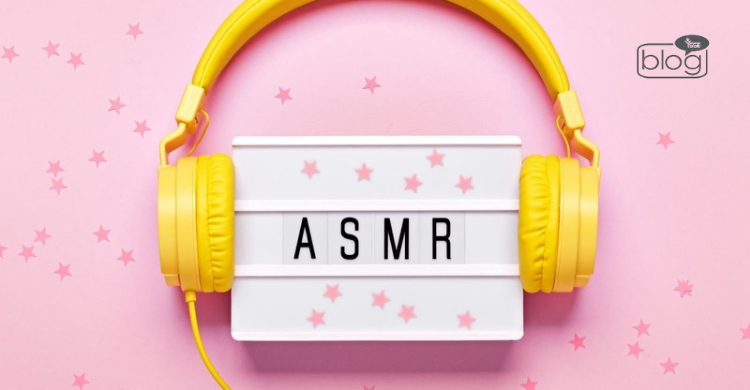The ASMR was first introduced in 2010 by Jennifer Allen, who wanted to make people aware about triggering sounds like tingling, rustling, whispering etc. against our sensation. ASMR stands for ‘Autonomous Sensory Meridian Response’. It’s a relaxing feeling an individual gets by hearing, touching, seeing and feeling certain things. The sensation often felt in the brain and travels towards the whole body or parts of the body. Often it feels chill down the back of the neck and spine. ASMR helps to sound sleep, relaxation or reduce anxiety and stress.
ASMR works by triggering a calming response in our brain. ASMR helps to relax our nerves by releasing dopamine, serotonin hormones. Common ASMR triggers include whispering, tapping sounds, soft crackling sounds, watching repetitive and slow movements etc.
People first discovered ASMR through listening to whispered sounds which became popular early triggers. A quiet close voice acts as a touchstone for creating calmness and personal connection. When you tap gently on wood, glass or plastic it generates pleasant sound vibrations for many ASMR users. People enjoy simulated haircuts and face inspections because they feel like real personal care. Many listeners find soothing comfort when they hear objects being crinkled such as paper or foil. Visitors note their stress decreases when they see people doing hand gestures or brushing their hair repeatedly at a slow pace. Some people struggle with eating sounds being triggers yet others do not share the same response to these noises. People react to trigger stimuli in their own specific ways which makes ASMR unique for every person.
But not everyone feels triggered. Some people feel nothing or someone feels irritated when exposed to these triggers. Beforehand, we always feel these feelings from nature or surrounding objects. But it didn’t have a name then. At present, in the modern era, it has a different name due to platforms like Facebook, YouTube. Today there are entire communities who are dedicated to this and have millions of fans. Lets go check out some trending ASMR: the 5 Most popular ASMR you need to hear and see.
Gym Chalk ASMR
Gym chalk ASMR focuses on the sound of chalk crushing, powder play, rubbing, and scraping. Dry and crisp auditory noises and slight grainy elements stimulate the auditory cortex which functions to process sound information. These chalk have different textures such as soft yet crunchy, squishy, dusty, hard and crunchy which are difficult to crush and give a relaxing rhythm to the audience. Also different colours of shade gives a joyas pleasure to the brain. Our brain creates ASMR tingles due to the unusual but non-aggressive characteristics that chalk sounds deliver to our ears. The rhythmic qualities within these sounds activate brain associations we have with peaceful activities which create feelings of order while promoting relaxation.
Ice Eating ASMR
Ice-cracking sounds have transformed into a well-known Autonomous Sensory Meridian Response trigger. The auditory signals triggered by fractured ice engage our brain connections properly as they excite our interest. Also the colours and flavours add the extra addiction. Soft powdery ice, hard little pieces of ice, big chunks, sticks or thin chips of ice have different crisp and sound. These audio triggers activate our ancient evolutionary responses as we listen to elements in nature unite to create satisfying aural effects. Audio of ice breaking along with purposeful eating noises makes the experience both rhythmic and hypnotic.
Mukbang
Through Mukbang ASMR viewers experience eating sounds at an advanced level as they view performers enjoy foods by chewing while making specific sounds. Brain mirror neurons activate when this style functions. The neurons which process empathy alongside imitation help us experience an event as if we are directly present. Many listeners experience satisfaction and relaxation from repetitive deliberate food sounds while they listen.
Whispered Story Telling ASMR
Humans naturally make and hear whispering sounds since these create emotional intimacy which then activates brain responses that promote relaxation. Through storytelling combined with the whispering technique brain engagement activates imaginative visualization that creates peaceful distractions from stressful daily experiences.
Hair Brushing and Hair Play ASMR
Hair brushing sounds combined with scalp care stimulate personal attention which lead to ASMR activation because they mirror attendant care that human beings receive. Brain stimulation occurs when these artificial sounds duplicate real-life grooming procedures that generally lead to feelings of security and care and tenderness. When brains detect grooming sounds they release endorphins which trigger a bodily experience of tingling relaxation.
Millions of people are fascinated by ASMR because it triggers their brain in unique and comforting ways through actions such as ice crunching and whispered narration. Discover these channels together with their triggering elements to identify the ASMR content you prefer then enjoy its calming benefits.
To read more blogs, click here
Writer
Most. Sirajum Munira
Intern, Content Writing Department
YSSE

